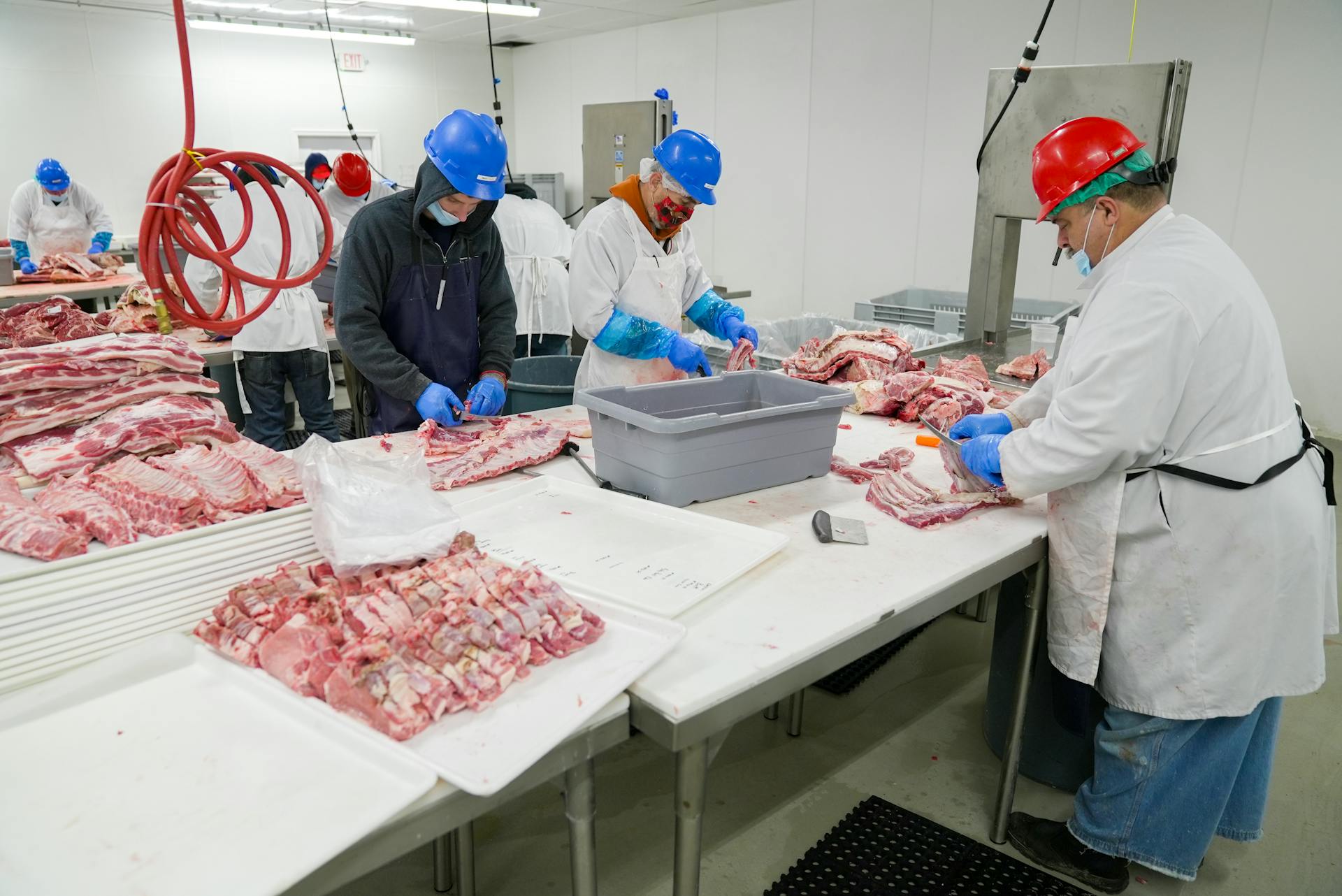
The USDA mortgage process can seem daunting, but breaking it down into smaller steps makes it more manageable.
First, you'll need to check your eligibility by meeting the income and property requirements.
The USDA sets income limits based on the area you're looking to purchase in, so it's essential to research these limits before applying.
To qualify, your household income must not exceed 115% of the area's median income.
Next, you'll need to find a USDA-approved lender who can guide you through the process.
USDA-approved lenders have a thorough understanding of the program and can help you navigate the application process.
Once you've found a lender, you'll need to submit a loan application, which includes providing financial documents and credit information.
This information is used to determine your creditworthiness and ability to repay the loan.
Broaden your view: Rural Development Loan Application
Eligibility
To be eligible for a USDA loan, you must meet specific requirements. The property you're interested in must be located in a USDA-eligible area, which can be found using the USDA's online eligibility tool. These areas are typically rural, but can also include suburban areas just outside of major metropolitan areas.
The USDA loan program is designed to help moderate to low-income families, and income limits vary depending on the location. In most U.S. counties, the standard USDA income limits are $110,650 for 1-4 member households and $146,050 for 5-8 member households.
To qualify for a USDA loan, you must have a debt ratio of 41% or less, and your credit score must be reasonable. You must also not have had any collection over the past year, and your credit must be verifiable. If your credit score is 680 or higher, you may qualify for streamlined processing of your loan.
Income Eligibility
Income Eligibility is a crucial aspect of the USDA Home Loan program. Your income must meet certain requirements to qualify for the loan.
To determine your eligibility, you'll need to check the specific income limits for your area, which can be found on the USDA's website. These limits vary depending on the number of people in your household, with higher limits for larger households.
You might like: Usda Home Loan Income Qualifications
For the spring of 2024 to spring 2025, the standard USDA income limits are as follows:
If you have a household with more than eight members, you can receive 8% of the four-person limit for each additional member.
Your adjusted gross income must be 115% or less of the median income in your area to qualify for a USDA loan. You'll also need to demonstrate a stable income and the ability to afford mortgage payments without incident for at least one year, based on your savings, current income, and total assets.
DTI Requirements
Your debt-to-income (DTI) ratio is a crucial factor in determining your eligibility for a USDA loan. This ratio is calculated by dividing your total monthly debt payments by your gross monthly income.
To qualify for a USDA loan, your DTI ratio should not exceed 41% of your income. However, if you have a credit score of 680 or higher, you may qualify for streamlined processing of your loan.
If this caught your attention, see: Do Deferred Student Loans Affect Debt to Income Ratio
Most lenders will also require that your PITI ratio (principal, interest, taxes, and insurance) does not exceed 34% of your income. This means that your mortgage payments should not be more than a third of your take-home pay.
Here's a breakdown of the DTI requirements for a USDA loan:
Keep in mind that these are general guidelines, and the lender may have their own requirements. It's essential to check with your lender to determine their specific DTI requirements.
You might like: Residential Rehab Hard Money Lender
Credit Requirements
To qualify for a USDA home loan, you'll need to meet certain credit requirements. Your credit score must be at least 620 FICO to be eligible. If your credit score is below 640, your lender will need to manually underwrite your loan, which may require more documentation and time.
The USDA's Guaranteed Underwriting System can expedite the process for borrowers with a credit score of 640 or higher. However, many lenders are still willing to help borrowers with lower scores through a manual underwriting process.
Curious to learn more? Check out: Lendingclub Credit Score
A borrower's payment history is also evaluated to ensure they have the ability and willingness to repay the mortgage. This means having no late payments or collections in their credit history within 12 months prior to applying for a USDA loan.
Here are the general credit requirements for a USDA loan:
- Minimum credit score of 620 FICO
- Manual underwriting required for credit scores below 640
- No late payments or collections in credit history within 12 months
Property Eligibility
To qualify for a USDA loan, the property being purchased must be located in a qualified rural area as set by the USDA, typically areas with less than 35,000 residents.
The USDA's online eligibility tool can be used to find out if a property is eligible for a USDA loan. This tool is easy to use and can help you quickly determine if a property meets the USDA's location requirements.
The property must serve as the primary residence for the borrower, and it must be less than 2,000 square feet in size. Additionally, the property cannot be an investment property, vacation home, or income-producing property.
For more insights, see: First Lien Heloc Investment Property
The property must also meet certain physical requirements, including having a functional heating and cooling system, an electrical system in safe operation with no frayed wiring, functional plumbing with no major backups or leaks, a solid foundation and roof, and no evidence of termite damage.
Here are some key property eligibility requirements:
- Location: Qualified rural area as set by the USDA (typically areas with less than 35,000 residents)
- Size: Less than 2,000 square feet
- Primary residence: Must serve as the primary residence for the borrower
- Property type: Cannot be an investment property, vacation home, or income-producing property
- Physical condition: Must meet certain physical requirements, including functional heating and cooling system, safe electrical system, functional plumbing, solid foundation and roof, and no termite damage.
Pre-Approval and Application
To get preapproved for a USDA loan, you'll need to provide your lender with some essential documents. These include paystubs, W-2s, bank statements, Social Security Awards letter (if applicable), and a photo ID.
Your lender will use these documents to verify your income and calculate your debt-to-income ratio (DTI). The USDA loan program considers both front-end and back-end DTI ratios. The front-end ratio looks at your proposed monthly housing cost in relation to your monthly income, while the back-end ratio considers all your major monthly debts.
The USDA benchmarks for DTI ratio are 34% for the front end and 41% for the back end. However, lenders often work with borrowers whose DTI exceeds these guidelines.
Recommended read: Monthly Payment Furniture No Credit Check
To get preapproved, you'll need to apply with a USDA lender and provide the necessary documents. This will give you a solid look at what you can afford and show home sellers that you're serious about making an offer.
Here's a breakdown of the documents you'll need to provide:
- Paystubs
- W-2s
- Bank statements
- Social Security Awards letter, if applicable
- Photo ID
Remember, preapproval is not a guaranteed loan approval. You'll still need to satisfy all credit and income conditions from underwriting, and the property must pass a USDA appraisal before final loan approval can be issued.
Broaden your view: Pre-approval for Usda Home Loan
Lender and Location
The lender and location are crucial aspects of the USDA mortgage process. You'll need to find a USDA-approved lender who suits your unique needs, and the property must be located in an eligible rural or suburban area.
To find a USDA-approved lender, consider factors such as loan expertise, interest rates, customer satisfaction, and the loan process. You can ask the lender about their experience with USDA loans, current market interest rates, and how they approach customer service.
For your interest: Convertible Debt Interest Rate
Here are some key points to consider when selecting a lender:
- Loan expertise: Ask how much experience the lender has with USDA loans and how much of their business comes from providing USDA loans.
- Interest rates: Understand how interest rates are determined and when the best time to lock in a rate may be.
- Customer satisfaction: Read online reviews and testimonials to get a sense of previous customers' experiences.
- Loan process: Ask about the lender's process and how they prioritize customer service and efficiency.
You can also visit the USDA's website to view an interactive map and determine if your home is in an area the USDA defines as rural.
Find a Lender
Finding a lender that's a good fit for you is a crucial step in the home loan process. You'll want to find a USDA-approved lender that suits your unique needs.
To get started, ask potential lenders about their experience with USDA loans. You can also ask how much of their business comes from providing USDA loans.
Interest rates can fluctuate daily, so it's essential to work with a lender who can help you determine when to lock in the best rate. This will ultimately depend on your credit score, debt-to-income ratio, and other factors.
Customer satisfaction is key when selecting a lender. Look for online reviews and testimonials to get a sense of previous customers' experiences. Pay attention to common themes like punctuality, efficiency, and friendliness.
Readers also liked: What Do You Pay Upfront When Financing a Car
Here are some factors to consider when evaluating a lender's loan process:
- Loan expertise: Look for lenders with experience and training on USDA loans.
- Interest rates: Understand how interest rates are determined and when to lock in the best rate.
- Customer satisfaction: Check online reviews and testimonials to see how previous customers have been treated.
- Loan process: Learn about the lender's process and whether they prioritize a personal connection or efficiency.
Location
To qualify for a USDA loan, the home must be located in an eligible rural or suburban area. The USDA loan program is designed to enrich rural communities and economies, so location is a crucial factor.
You can check if a property or location qualifies by visiting the USDA's website, where you'll need to provide the home's address. The USDA's website has a property eligibility map that you can use to do a quick look-up.
The USDA defines a rural area as one that is outside a city or town, not in an urban area. The department also sets specific maximum population thresholds, as defined by the census.
Any area that once met the USDA's definition of rural but lost this designation after the 1990, 2000, or 2010 census may still be eligible, as long as the area's population does not exceed 35,000. This means that many places aside from cities or metropolitan regions may still qualify.
See what others are reading: Equity Loan on Rental Property
Frequently Asked Questions
How long does it take for an USDA loan to be approved?
USDA loan approval typically takes 30 days or less, once a complete case file is received by the Loan Approval Official
What is the timeline for USDA underwriting?
The USDA underwriting timeline typically ranges from 30 to 60 days, but can be longer for manual underwriting loans. Additional requirements, like the USDA appraisal, may contribute to a longer underwriting process.
Is it hard to get approved for a USDA loan?
Getting approved for a USDA loan is possible with a minimum credit score of 620, but borrowers with lower scores may still be eligible with additional review. Approval requirements can vary, so it's worth exploring further to see if you qualify.
What are the requirements for a USDA loan in Kentucky?
To qualify for a USDA loan in Kentucky, your household income must be within the limits of $110,650 for 1-4 family members or up to $153,500 for 5 or more. Contact a USDA loan specialist to learn more about making your new Kentucky home a reality.
Featured Images: pexels.com


